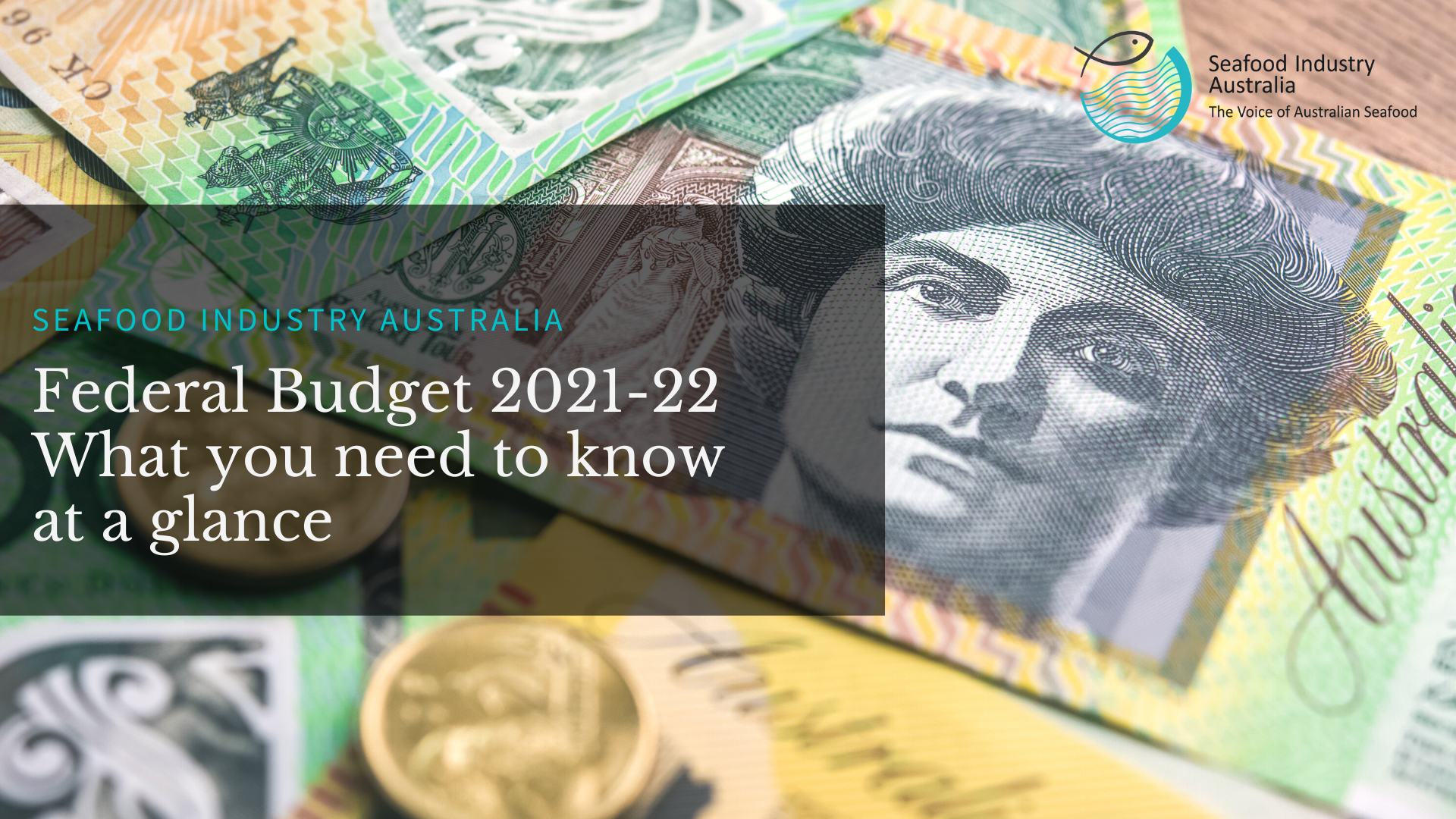There were a number of announcements in last night’s 2021-22 Federal Budget that will support the Australian seafood industry, announced as part of the Government’s economic recovery plan for Australia, and Seafood Industry Australia welcomes these announcements. A copy of our media statement can be found here.
The Morrison Government has committed to continue working closely with Seafood Industry Australia to ensure the Australian seafood industry remains prosperous, and is ready to face the opportunities and any challenges that await us in the future.
The Australian Government has been a strong supporter of the Australian seafood sector throughout 2020 and early 2021, providing assistance through natural disasters, the coronavirus pandemic and trade disruptions to key markets. The Morrison Government has committed to continue this support in 2021-22, and into the future.
- E-fish and electronic monitoring
- For Commonwealth fishers, the Australian Government will inject $20.1 million into leading edge data integration, monitoring and artificial intelligence to reduce regulatory burden, increase productivity, support new export opportunities, and improve environmental outcomes. The package includes the $9.95 million E-Fish initiative and the $10.1 million E-Monitoring program that will boost innovation and lower compliance costs. The package will be developed and implemented by the Australian Fisheries Management Authority (AFMA) in consultation with industry.
- A copy of SIA’s joint media statement with CFA welcoming the announcement is available here.
- Oceans Leadership Package
- The government has also announced the $100.1 million Ocean Leadership Package to build ocean’s health and resilience while supporting jobs and economic activities in Australian communities.
- A copy of the SIA media statement welcoming the announcement is available here.
- Of relevance to the commercial fishing industry, the package includes $18 million under a “Sustainable Ocean Action” measure, which will provide $5 million to support cross-jurisdictional efforts to improve the environmental stewardship of our fisheries through reducing and mitigating bycatch of threatened and migratory species.
- Details of the expenditure are still being worked through, however the funds will be used to implement priority actions in the National Policy on Fisheries Bycatch (1999) and the Commonwealth Fisheries Bycatch Policy (2018); while broadening the scope to encompass all relevant Australian jurisdictions.
- Also of relevance to the commercial fishing industry, is the inclusion of $39.9 million towards supporting Australian Marine Park partnerships. This measure will fund two additional rounds of the successful Our Marine Parks Grants program, targeting practical but innovative initiatives to promote stewardship and sustainable management of Australian Marine Parks, while supporting regional jobs.
- Asset write-off extension
- The budget includes a year-long extension to the temporary full expensing measure, formerly known as the instant asset write-off.
- The measure, for which 99 per cent of businesses are eligible, allows businesses with annual turnover of less than $5 billion to immediately deduct from their tax bill the full cost of eligible depreciable assets up to any value. It is aimed at boosting investment and will apply to assets purchased after 7.30pm on October 6, 2020 and first used or installed ready for use by June 30, 2023.
- Ag 2030
- The Budget confirms the Australian Government’s ongoing commitment to ensure the agriculture industry is well placed to reach its goal of $100 billion by 2030. This Budget builds on actions already taken by the Australian Government to drive competitiveness and growth laying the foundations to support agriculture, fisheries and forestry industries reach the target of $100 billion in value by 2030. The Agriculture 2030 package is about removing the handbrakes to growth, tackling emerging trade challenges early, protecting our country from pests and disease, supporting industry resilience and productivity, boosting innovation and human capital availability. We have also committed $5.4 million to back fair, strong and resilient supply chains. We will work with perishable agricultural goods supply chains, including within the seafood sector, to identify market transparency issues and develop tools to improve price and market transparency.
- More detailed information on the government’s plan to support industry reach its Ag2030 goal will be made available at www.awe.gov.au/Ag2030.
- Biosecurity support
- The new $371 million biosecurity package announced by the Prime Minister on May 4, strengthens Australia’s ability to keep out exotic pests and diseases, and improves our ability to eradicate those pests and diseases present in Australia to protect our export market access. The package includes $67.4 million to support Australia’s biosecurity preparedness and response capabilities, and $34.6 million for research and improved field tools to better understand how pests and diseases could enter the country, particularly in northern Australia.
- Additional trade support
- The Ag 2030 package includes $15 million to step up Australia’s leadership in international institutions and global policy debates that underpin our agriculture and fisheries trade. We will appoint a new international agriculture envoy dedicated to protecting and promoting Australia’s international interests. The measure also provides for enhanced Australian influence and engagement in international institutions that set standards for food and agriculture trade. This measure builds on current initiatives designed to support export growth, including the Busting Congestion for Agricultural Exporters package announced in the 2020-21 Budget and the Agri-Business Expansion Initiative announced in December 2020, which is essential if Australia’s agriculture and fisheries industries achieve the goal of $100 billion in output by 2030.
- New national climate service
- Finally, the government is providing $210 million to establish the Australian Climate Service, which will bring together our best scientists to help us better anticipate, manage and adapt to climate impacts. By bringing together critical data from key institutions such as the Bureau of Meteorology and CSIRO, the Australian Climate Service will be able support the sector in anticipating and adapting to changes to ensure it can continue to deliver healthy and sustainable seafood to Australian and international markets.
Furthermore, we have included a top-line summary of the key points of interest from the budget below:
- A major component of the government’s jobs plan is a $506.3 million, two-year extension of the JobTrainer program to support 163,000 new training places, and upskill those seeking work.
- Australia’s low and middle income earners will get almost $8 billion back from the government after a key tax break was extended. The Low and Middle Income Tax Offset will benefit more than 10 million people and is worth up to $1080 for individuals and $2160 for dual income couples.
- The budget committed $2.3 billion mental health and suicide prevention, including more Headspace centres to support young Australians, increased funding for the treatment of people with eating disorders and greater access to psychiatrists, psychologists and GPs through Medicare. There will also be a Royal Commission into defence and veterans suicide.
- The government also extended for a further 12 months to June 30, 2023, the temporary loss carry-back measure. This allows businesses – when they lodge their 2022-23 tax return – to carry back tax losses from the 2022-23 income year to offset previously taxed profits as far back as 2018-19.
- From July 1 next year, the $450 per month threshold for compulsory superannuation will be removed, meaning employers will have to pay super to low paid workers, such as part-time staff and casuals.
- From the same date, the government will allow individuals aged 67 to 74 years to make or receive non-concessional or salary sacrifice superannuation contributions without meeting the so-called work test.
- An additional $2.7 billion spend over four years will also support 170,000 apprenticeships.
- Support for job seekers and a plan to modify existing unemployment services will also get $258.6 over four years.
- The $1.7 billion boost to childcare will slash costs for a quarter of a million families by $2200 each year, and encourage more women into the workforce.
- The childcare subsidy annual cap will be removed from July 2022, with increased subsidies to be available for families with two or more young children.
- An additional $15.2 billion spent on major infrastructure projects such as the Great Western Highway in NSW and the Melbourne Intermodal Terminal will create 30,000 jobs.
- The federal government is also investing $1.2 billion on its Digital Economy Strategy, including a digital skills cadetship.
- Incentives will be offered for those looking to downsize their home when they reach 60.
- A $3.4 billion package was outlined in a women’s budget statement, which focuses on safety, economic security, health and wellbeing. Including payments worth up to $1500 for women escaping domestic violence as part of a two-year trial.
A copy of the Treasurer’s speech is available here, and for more information on the 2020-21 Federal Budget, or specific points please www.budget.gov.au.







